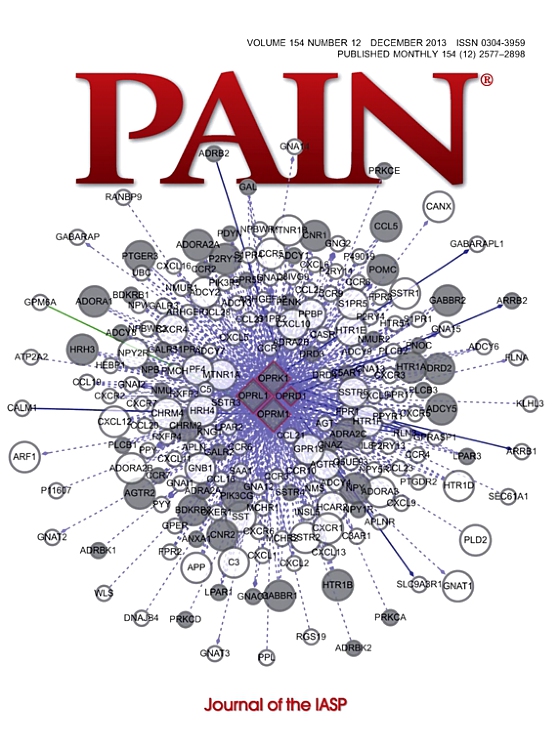Sex-related differences in cannabidiol's antinociceptive efficacy in a trigeminal neuralgia rodent model.
IF 5.9
1区 医学
Q1 ANESTHESIOLOGY
引用次数: 0
Abstract
Trigeminal neuralgia (TN) is a severe orofacial pain condition with sex-specific differences in pain responses. Standard treatments offer limited efficacy and significant side effects. We hypothesized that cannabidiol (CBD) alleviates TN-induced allodynia more effectively than carbamazepine in a sex- and dose-dependent manner through neuroimmune mechanisms, including modulation of glia, Fos protein expression, and oxidative stress in the ventrolateral periaqueductal gray (vlPAG) and spinal trigeminal nucleus caudalis (Sp5c). In an infraorbital nerve constriction model, mechanical allodynia was evaluated in male and female Wistar-Hannover rats. Our study demonstrates the potent antinociceptive effects of CBD in reducing mechanical allodynia in both male and female models of trigeminal neuralgia, without affecting locomotor activity, unlike carbamazepine. Although CBD's analgesic effects were consistent across sexes, carbamazepine showed sex-dependent efficacy. Cannabidiol's effects on Fos-B were region- and sex-dependent: it inhibited Fos-B in the Sp5c in both sexes but only in males in the vlPAG, suggesting sexually dimorphic activation of descendent pain circuits. Cannabidiol prevented superoxide oxidation in the vlPAG in both sexes, with effects on microglia and astrocytes at similar doses, suggesting that glial cells produce the oxidative stress inhibited by CBD. In the Sp5c, CBD modulated Fos-B, superoxide oxidation, microglia, and astrocytes in both sexes, indicating a possible lack of sexual dimorphism in this region. These results highlight CBD's efficacy in managing TN by modulating ascending and descending nociceptive pathways. Beyond its neuronal effects, CBD's analgesic actions in TN may also involve significant modulation of glial cell activity, underscoring the complexity of its therapeutic mechanisms.大麻二酚在三叉神经痛啮齿动物模型中抗伤害感受效果的性别相关差异。
三叉神经痛(TN)是一种严重的口面部疼痛状况,疼痛反应具有性别特异性差异。标准治疗的疗效有限,副作用显著。我们假设大麻二酚(CBD)通过神经免疫机制,包括调节神经胶质细胞、Fos蛋白表达和腹外侧导水管周围灰质(vlPAG)和脊髓三叉神经尾核(Sp5c)的氧化应激,以性别和剂量依赖的方式,比卡马西平更有效地缓解n诱导的异位性痛。在眶下神经收缩模型中,对雄性和雌性Wistar-Hannover大鼠的机械异常性痛进行了评估。我们的研究表明,与卡马西平不同,CBD在减少男性和女性三叉神经痛模型中的机械异常性疼痛方面具有有效的抗伤害性作用,而不影响运动活动。尽管CBD的镇痛作用在性别上是一致的,卡马西平的效果是性别依赖的。大麻二酚对Fos-B的影响是区域和性别依赖的:它在两性中抑制Sp5c中的Fos-B,但在vlPAG中仅在雄性中抑制,这表明后代疼痛回路的性别二态激活。大麻二酚可以防止两性vlPAG中的超氧化物氧化,在相同剂量下对小胶质细胞和星形胶质细胞产生影响,表明胶质细胞产生被CBD抑制的氧化应激。在Sp5c中,CBD在两性中调节Fos-B、超氧化物氧化、小胶质细胞和星形胶质细胞,表明该区域可能缺乏性别二态性。这些结果强调了CBD通过调节上升和下降的伤害性通路来管理TN的功效。除了其神经元作用,CBD在TN中的镇痛作用也可能涉及神经胶质细胞活性的显著调节,强调其治疗机制的复杂性。
本文章由计算机程序翻译,如有差异,请以英文原文为准。
求助全文
约1分钟内获得全文
求助全文
来源期刊

PAIN®
医学-临床神经学
CiteScore
12.50
自引率
8.10%
发文量
242
审稿时长
9 months
期刊介绍:
PAIN® is the official publication of the International Association for the Study of Pain and publishes original research on the nature,mechanisms and treatment of pain.PAIN® provides a forum for the dissemination of research in the basic and clinical sciences of multidisciplinary interest.
 求助内容:
求助内容: 应助结果提醒方式:
应助结果提醒方式:


